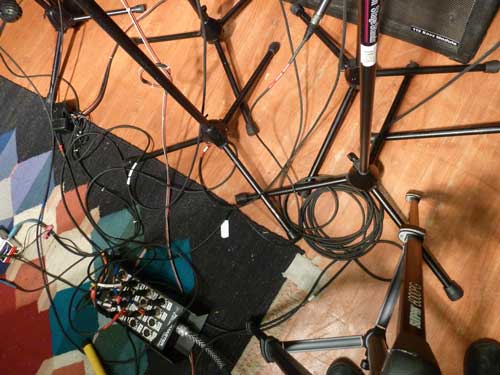|
10.14.13
Mics for a guitar amplifier.
Selecting microphones to record a guitar amplifier can get very involved, especially when the sound coming from the amp is very distorted. We're unusual because, like the bass amplifier, our guitar amplifier is also biamped. There's a 2 x 12 cabinet that's the high end and a 1 x 15 that captures the low end. Microphone choice and placement make all the difference between a recording that carries the complex detail of a meltdown amp sound vs. an instant washed-out headache for the listener. This last part may sound cool for those who like noisy music, but if I wanted our guitar to sound like someone left a vaccuum cleaner on, it would sound like that as we play it. It doesn't, so the recording should be more than a roaring blur.
LOW FREQUENCY CABINET
Fortunately, we spent a bunch of effort last time narrowing down [ microphone choices ] and [ placement ] . I discovered that the 1 x 15 cabinet is so similar among the choices that I'd go simple: put a good omni mic - in this case a Earthworks TC30K - right in front of the middle of the cabinet's speaker and be done with it.
HI FREQUENCY CABINET
The high frequency cabinet was much more touchy. After a bunch of trial and error, I realized that the only way I could improve on a well-positioned beyer m160 was if I blended it with another microphone on the same cabinet. Last time that ended up being a Royer 121. Testing against that would be the starting point this time.
Since I know I like the beyer mic, the comparison would be what it sounds like to blend it with the Royer and two other choices. Here are four different choices, including just having the m160 by itself.
1. Shure SM-7
2. A beyer m160 by itself
3. Coles 4038
4. Royer 121
The beyer and the Shure are using the stock channels of the Sytek MPX 4A; the Coles and Royer are each using the AEA TRP. The low frequency cabinet is the Earthworks mic, probably at about 1/2 the level as the other mics. For this comparison, I'm going through each of the choices with the sound label, then cycling through again without the label to emphasize the differences.
Let's see if I can describe what I'm hearing: on each of the four examples, the similar sound of the guitar chugging along is also paired with a distinct hissss sound. On each of the different microphone choices, the distinctive frequency of the hiss is different. I've ordered there here from highest to lowest. Now the result of that different frequency hiss has an impact when mixed in with other instruments. Sample 1, the Shure, sounds comparatively duller than the other three despite the fact that its hiss is the highest. The other three sound sharper in a way that I like. The differences between the other three are not that great here.
But the hiss also seems louder or softer in the different combinations. Take the same setup, but playing a much noisier, treble-ier guitar part.
In this one, you can really hear the hiss switch between 1, 2 and 3 but it stays at about the same level. But, in part because the hiss frequency on 4 is lower, it is much less apparent. (Soundcloud's limitations on sound resolution really start to come through here.)
So I hear that the SM-7 has the most noticeable hiss and sounds dullest. Of the other three, the Royer has the least apparent hiss while still keeping most of the detail. So it's the Royer 121. (I'm a little bummed; that Coles is a cool/not-cheap mic.)
DECISION TIME
- The guitar's high frequency cabinet will be a 50/50 mix of the beyer m160 and the Royer 121.
- The guitar's low frequency cabinet will still be the Earthworks TC-30K.
All that monkeying around and we're back in the same place. Huh.
Next up: what kind of preamps are we going to run these fellas through?
[ PREVIOUS ]
[ ARCHIVE ]
[ NEXT ]
|
|  |
 |
 |


It can get messy, and taking these pictures doesn't help.


Guitar rig. Top is the 2 x 12, broadcasting the high-frequency part of the bi-amp to the four mic choices. (l-r: Royer, Shure, beyer, Coles) The bottom is a 1 x 15, sending out the low-frequency part of the bi-amp to the Earthworks mic.

|
 |
 |
 |
[ LATEST UPDATE ]
[ Archives ]
CONSTRUCTION
[ Overview ]
[ Basic Construction ]
[ Acoustics ]
[ HVAC ]
[ Electrical ]
[ The Grand Vision ]
[ Tool Reviews ]
[ Links and Resources ]
|